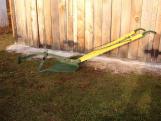2
In 2002, the William Phanenhour family of Westmeath Township, Ontario, Canada, donated a walking plow to Ross Museum, Foresters Falls, Ontario, Canada. This plow was previously owned by Harris Brown and had been purchased from Vernard Brown, Harris's son, when he left the Brown farm near Beachburg, Ontario, Canada.The history of the plow and the Brown family has been well documented by Vernard's daughter, Barbara Brown Hare and was the inspiration for this story: "Plowing A Furrow To Victory."
4
The Man Behind the PloughI'm not so much at speaking as those high faluting chaps
My voice - it may be husky or a little proud perhaps
For I've been aploughin' with this lazy team you see
And it keeps me pretty busy with the giddap, haw, and gee.
But if you'll pay attention, I have just a word to say
About a great mistake you make, and do it every day.
In dealing out your praises, and I'd like to tell you now,
That far too often you forget the man behind the plough.
Your painters and your poets, they get praises everywhere.
Then well enough to make a show, but can you tell me how,
The world could ever do without the man behind the plough?
I like your great inventions, and I'm glad you're getting smart.
I like to hear your music, it kind of stirs my heart,
But 'twill never reach the stomach of a real hungry man;
And so I'll call attention to the kind of thing that can.
So boys don't be too anxious to leave the good old farm,
Your father's strength is failing, soon he'll need your youthful arm.
If you are honest in your purpose, at your feet the world will bow,
For the greatest of the great men is THE MAN BEHIND THE PLOUGH.
6
A plough is an implement to turn or break up soil. Both spellings are correct,"plow" is the American spelling and "plough" is used in the British Isles, Europe and found in historical records.8
The plow probably originated in Egypt and South West Asia in the bronze age, 2500 BC, as a single piece of wood drawn by a man and later, about first century BC, drawn by draught animals and in the twentieth century by a tractor.Iron plows developed in the iron age (475-221 BC), greatly improved the method of plowing when a flat V-shaped iron piece was probably mounted on wooden blades with wooden handles.
9
Oxen were used to pull plows, harrows and wagons because they provided more strength than a horse.1800

10
Today we think of horses as the primary power source on the pioneer farm. However, in the 1851 Westmeath Township Census, there were 2,358 oxen and 1,232 horses.Research tells us that oxen are much stronger than the average draught horse as well as being more hardy and easier to maintain, all important to a pioneer farmer. They could pull plows, harrows and wagons, and their power rendered them useful for hauling logs and removing stumps.
An early Beachburg pioneer remembered huge quantities of timber being cut in the surrounding localities, made into square loads and hauled through the village by eight span of oxen. ( as recounted by Mrs. James Barr, of Beachburg, Ontario, Canada, a member of the Women's Institute.)
12
In North America, the first plows used by the pioneers were wooden. Later, immigrants often brought iron plows from their homelands as they were developed.The early settlers in Upper Canada were provided with an assortment of tools; one of which was a primitive plow, a gift from King George III.
14
The share or point of the plow was early made of iron or steel and mouldboard often faced with metal, a technique introduced by John Deere, and Leonard Andrus around 1837.There were several different types of plows made and patented in Eastern Ontario from the mid 1800's.
The Harris Brown plow at Ross Museum is a Fleury Scotch Thistle #53 plow manufactured by the Fleury Plow company of Aurora, north of Toronto, Ontario, Canada. This company was founded by Joseph Fleury, who set up a blacksmith shop in Aurora in 1857, forming his plow company in 1859, which became known world wide.





